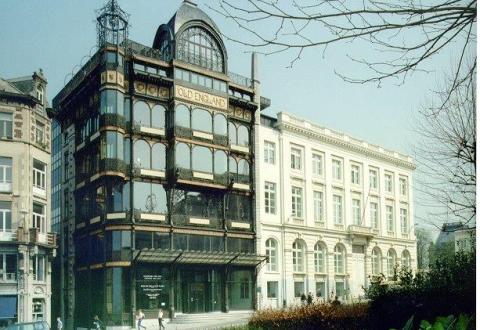The MIM and the Royal Conservatory of Music
Shortly after the museum’s founding in 1877, the collection was stored in an annex of the Royal Conservatory of Music on rue aux Laines (Wolstraat). The Conservatory itself moved into a new building on rue de la Régence (Regentschapsstraat), designed by architect Jean-Pierre Cluysenaar.
The museum also acquired a large townhouse on the corner of Place du Petit Sablon (Kleine Zavel), which became the residence of director François-Auguste Gevaert (1828–1908). However, the collection grew so rapidly that new premises soon became necessary.
Furthermore, the storage conditions for the...
Shortly after the museum’s founding in 1877, the collection was stored in an annex of the Royal Conservatory of Music on rue aux Laines (Wolstraat). The Conservatory itself moved into a new building on rue de la Régence (Regentschapsstraat), designed by architect Jean-Pierre Cluysenaar.
The museum also acquired a large townhouse on the corner of Place du Petit Sablon (Kleine Zavel), which became the residence of director François-Auguste Gevaert (1828–1908). However, the collection grew so rapidly that new premises soon became necessary.
Furthermore, the storage conditions for the instruments required urgent improvement. The situation became so critical that in 1926 Louis Cavens threatened to reclaim the items he had donated if the government did not take appropriate action. Although promises were made, these amounted only to temporary measures. The storage facility on rue aux Laines (Wolstraat) was expanded, and the beautiful building on the corner of the Sablon (Zavel) was converted into an exhibition space.

Old England building
Not until the late 1970s - by which time the collection was spread over no fewer than fifteen buildings in the Sablon and Nord/Noord districts - did the federal government realise that a comprehensive solution was needed for the MIM. In 1978, the former Old England buildings were finally purchased to house not only the exhibition rooms but also the reserves and administrative offices.
These two buildings are very different in style. The neoclassical building on the Place Royale (Koningsplein) is part of the overall design for the entire square, laid out in 1774 under the direction of...
Not until the late 1970s - by which time the collection was spread over no fewer than fifteen buildings in the Sablon and Nord/Noord districts - did the federal government realise that a comprehensive solution was needed for the MIM. In 1978, the former Old England buildings were finally purchased to house not only the exhibition rooms but also the reserves and administrative offices.
These two buildings are very different in style. The neoclassical building on the Place Royale (Koningsplein) is part of the overall design for the entire square, laid out in 1774 under the direction of architect Barnabé Guimard. It was inspired by the Place Stanislas in Nancy.
The building on the Montagne de la Cour (Hofberg) is one of Brussels’ art nouveau gems. It was constructed in 1899 following a design by architect Paul Saintenoy. Additionally, a third, newly erected building on rue Villa Hermosa was created for storing items not on display.
The renovations and preparations took several years to complete. In December 1998, the MIM officially received the keys to the buildings. The collection was transferred during 1999, a move that took ten months. The new MIM opened its doors in June 2000.
